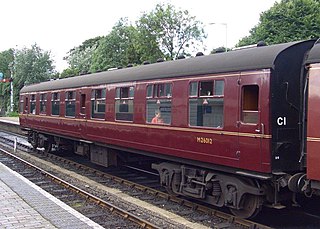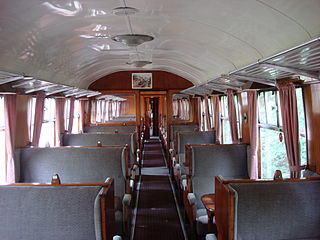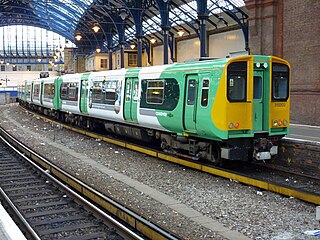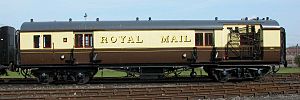
The vacuum brake is a braking system employed on trains and introduced in the mid-1860s. A variant, the automatic vacuum brake system, became almost universal in British train equipment and in countries influenced by British practice. Vacuum brakes also enjoyed a brief period of adoption in the United States, primarily on narrow-gauge railroads. Their limitations caused them to be progressively superseded by compressed air systems starting in the United Kingdom from the 1970s onward. The vacuum brake system is now obsolete; it is not in large-scale usage anywhere in the world, other than in South Africa, largely supplanted by air brakes.

The Great Central Railway (GCR) is a heritage railway in Leicestershire, England, named after the company that originally built this stretch of railway. It runs for 8.25 miles (13.28 km) between the town of Loughborough and a new terminus in the north of Leicester. It has period signalling, locomotives and rolling stock.

The British Rail Class 05 is a class of 0-6-0 diesel-mechanical shunters built by Hunslet Engine Company from 1955 to 1961. They were used on the Eastern and Scottish Regions of British Railways. The first two batches were delivered as 11136-11143 and 11161-11176. Subsequent locomotives were delivered, new, as D2574-D2618.

A train reporting number in Great Britain identifies a particular train service. It consists of:

The Second Corridor type of railway carriage was one of the standard mid-20th century designs, and was coded SK by the LNER and BR, and CF by the LMS. The layout of the coach was a number of compartments, all of which were second class, linked by a side corridor.

The Rushden, Higham and Wellingborough Railway is a heritage railway operated by the Rushden Historical Transport Society in the town of Rushden in the county of Northamptonshire, England.

In 1933, the Great Western Railway introduced the first of what was to become a successful series of diesel railcars, which survived in regular use into the 1960s, when they were replaced with the new British Rail "first generation" type diesel multiple units.

British Rail Mark 1 is the family designation for the first standardised designs of railway carriages built by British Railways (BR) from 1951 until 1974, now used only for charter services on the main lines or on preserved railways.

The Mark 2 family of railway carriages are British Rail's second design of carriages. They were built by British Rail workshops between 1964 and 1975 and were of steel construction.
A wide variety of hauled coaches have been used on the railways of Ireland. This page lists all those since 1945.

A Travelling Post Office (TPO) was a type of mail train used in Great Britain and Ireland where the post was sorted en route, used from 1830 to 1996, with non-TPO mail trains ending in 2024.

The British Rail Class 313 was a dual-voltage electric multiple unit (EMU) train built by British Rail Engineering Limited's Holgate Road carriage works between February 1976 and April 1977. They were the first production units that were derived from British Rail's 1971 prototype suburban EMU design which, as the BREL 1972 family, eventually encompassed 755 vehicles over five production classes. They were the first second-generation EMUs to be constructed for British Rail and the first British Rail units with both a pantograph for 25 kV 50 Hz AC overhead lines and contact shoe equipment for 750 V DC third rail supply. They were, additionally, the first units in Britain to employ multi-function automatic Tightlock couplers, which include electrical and pneumatic connections allowing the coupling and uncoupling of units to be performed unassisted by the driver whilst in the cab.

A Post Office sorting van is a type of rail vehicle built for use in a Travelling Post Office.
A Post Office stowage van is a type of rail vehicle built for use in a travelling post office (TPO). Several of these have passed into preservation as they are very useful for storage on the railways.

The British Rail Class 501 electric multiple units were built in 1955/56 for use on the former LNWR/LMS suburban electric network of the London Midland Region. A total of 57 three-car units were built.

The British Rail Class 27 is a diesel locomotive built by the Birmingham Railway Carriage and Wagon Company (BRCW) during 1961 and 1962. They were a development of the earlier Class 26; both were originally classified as the BRCW Type 2. The Class 27s were numbered D5347-D5415.

British Rail Universal Trolley Equipment (BRUTEs) were trolleys used from 1964 until 1999 for sorting, handling and transport by rail of parcels, newspapers, etc.
The London and North Eastern Railway (LNER) inherited several styles of coaching stock from its constituents. Sir Nigel Gresley continued the styles that he had established pre-grouping at the Great Northern Railway (GNR) and for the East Coast Joint Stock.
The Bluebell Railway is a heritage line West Sussex and East Sussex in England.

The Southern Railway Maunsell carriage was the first design family of railway carriages built by Richard Maunsell for the Southern Railway (SR) in the United Kingdom. Following grouping in 1923, SR had continued to build carriages to the designs of the previous three main companies, and the Maunsell carriage was intended to be the standard carriage design for use across the Southern Railway lines, incorporating the best features of each of the former companies' designs.
















